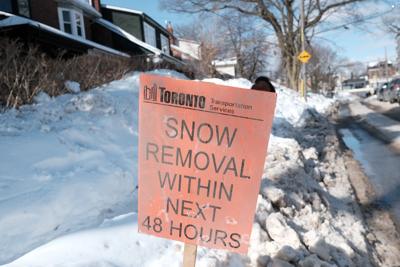This past weekend, ╔ź╔ź└▓ got walloped with snow.
That shouldnÔÇÖt be newsworthy ÔÇö after all, we live in Canada. It ended up being so, however, because the city was brought to its knees.
Despite the forecasts, the City of ╔ź╔ź└▓ allowed snow to pile up across four separate snow events ÔÇö the first starting as far back as Super Bowl Sunday ÔÇö before operations were mobilized to start removing snow, a full 10 days after the first snowstorm.
The net effect has been countless hours of shovelling, two-way streets turned into one-way streets, emergency vehicles stuck with no space to manoeuvre, and seniors left stranded.
City staff have said it will take three weeks to clear the snow. ItÔÇÖs hard to believe that in the biggest city in Canada, Mayor Olivia Chow not only accepts this answer, but can crack a joke about not calling in the army.
Residents are frustrated, and they are demanding answers about how this happened and how we ensure it doesnÔÇÖt happen again.
This is not a funding issue┬áÔÇö our snow clearing budget comes in at $160 million this year, supported by a 23.4 per cent property tax increase over the past three years.
Rather, this is about a lack of accountability and leadership, and the need to demand better performance.
LetÔÇÖs look at a comparable city. At 2,800 square kilometres, the City of Ottawa is more than four times the size of ╔ź╔ź└▓. (Though only 10 per cent of Ottawa is urban, while the remaining 90 per cent is agricultural land, villages, marginal and forested lands, and wetlands, according to the city of Ottawa’s website).
Still, Ottawa is also responsible for more than 6,000 km of roadways, versus 5,600 km in ╔ź╔ź└▓.
When the same weather systems hit our nationÔÇÖs capital this month, roughly 40 centimetres of snow fell during a 24-hour period. OttawaÔÇÖs snow operations got to work immediately, plowing and beginning snow removal within 24 hours. OttawaÔÇÖs winter operation budget comes in at $95 million, just over half of ╔ź╔ź└▓ÔÇÖs budget.
Ottawa delivers better performance over a larger area at a lower price tag.
╔ź╔ź└▓ also used to have better performance. In January 2022, nearly 50 cm of snow fell on the city in a single storm. Crews got to work immediately, removing 17,000 tonnes of snow in the first six days. While even then, there was room for improvement in response, residents deserve answers for why that type of urgency was not seen this time.
Accountability also requires answers about why the TTC was rendered nearly useless, despite official city recommendations to take transit instead of driving.
On Sunday of the Family Day long weekend, major parts of our public transit system were not functional. Service between Bloor-Yonge and Yonge-Eglinton was shut down for 24 hours. Delays on both lines continued well into the work week, problems which could have been mitigated by storing trains inside tunnels overnight and proactively maintaining rails and switches.
Instead of leading on this issue and taking responsibility for the cityÔÇÖs response, the mayor was conspicuously absent for a week. Mayor Chow first directly spoke out about the storm in a tweet where she admonished drivers for parking on snow and streetcar routes, posting a picture of a vehicle parked next to a four-foot wide mound of snow on Dundas Street West. Before pointing the finger at drivers, one might wonder why snow still hadnÔÇÖt been removed on one of our cityÔÇÖs busiest thoroughfares, two full days after the storm had finished.
In fact, I have still yet to see the mayor take any accountability for the lack of service, prioritization, or co-ordination of winter services, or a proposed strategy to do better.
Unfortunately, this lack of accountability and leadership appears to be a pattern. Too often, City Hall is spending time explaining why snow isnÔÇÖt cleared, parks arenÔÇÖt cleaned, and dead raccoons arenÔÇÖt picked up ÔÇö instead of owning up to shortcomings and making the changes necessary to improve service.
Local governments need to prioritize core services and deliver on the basics┬áÔÇö and in Canada, that includes clearing the streets after a snow storm, and making sure that transit is running when residents rely on it most.
In the private sector, consistent failure and mediocre performance is not tolerated for long. And when ╔ź╔ź└▓nians are shouldering significant tax increases year after year, without seeing an improvement in city services, itÔÇÖs no wonder their patience is running thin.
Correction — Feb. 25, 2025
This article has been updated. City Councillor Brad Bradford is no longer vice chair of the planning and housing committee. A previous version incorrectly stated he currently has that title. 
Clarification — Feb. 25, 2025
This file has been updated to clarify the urban/rural split in Ottawa, in terms of square kilometres.





























To join the conversation set a first and last name in your user profile.
Sign in or register for free to join the Conversation